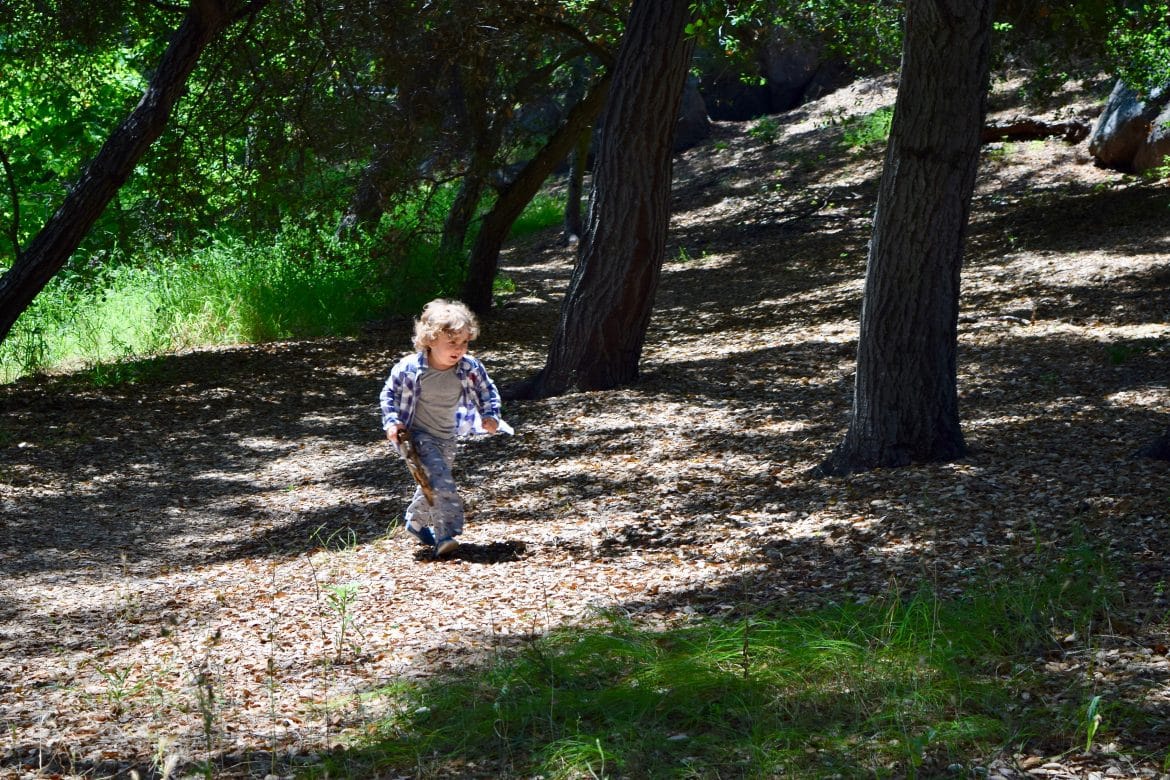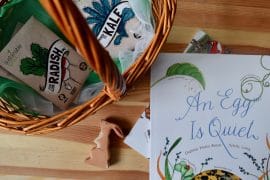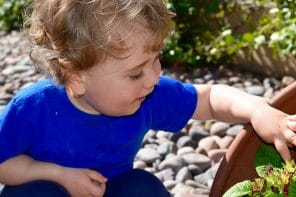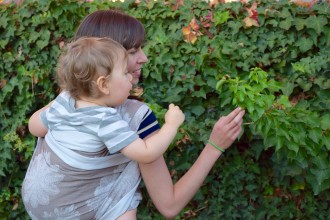I tried to remember what some of my favorite toys were the other day. And aside from a handful of basic things like blocks and dress up, I couldn’t think of much. But what did come to mind was the secret “hideout” my friend and I had, which was basically a few big bushes with a natural little tunnel. There was also a giant tree near a playground that was perfect for climbing and swinging. Then I thought about all the sticks, rocks, flowers, giant poles of bamboo, sand, and trees that all served as the best kind of open ended toys. With nothing but nature at our disposal, my friends and I could be anything from medieval knights/princesses to astronauts to superheroes.
Drawing my attention back to my three year old son, I reflected on what brings him the most joy. He has wonderful open ended toys, a comfortable bedroom, millions of books, and a fully stocked kitchen. All things that I know he loves. But I see the widest smiles, the biggest movements, and the most enthusiasm when we are outside. Particularly because he is a young boy with a TON of energy, giving him the means to be a wild child is one of the best things that I can do for him.
Children, perhaps because they are so free and instinctual anyway, usually love to be outdoors. And it makes a ton of sense, not only because the outdoors aren’t just a place to play, but they serve as one of the most important ways to improve physical and mental development.
Getting children outside helps to:
- Improve motor skills. Gross motor skills improve when they run, skip, jump, and climb. Fine motor skills get a boost from picking up and examining bugs, rocks, leaves, seeds, etc.
- Boost vitamin D levels. Most people are vitamin D deficient and the best way to get it is through sunshine.
- Stabilize mood and sleep. It’s been proven again and again that the simple act of being outside reduces stress, regulates hormones, improves our sleep by getting our internal clock back into sync, and generally makes us happy.
- Keep kids healthy. Outside air is much lower in pollutants than indoor and better to breathe. But being outside also keeps immune systems working by introducing a child’s body to naturally occurring microbes and good ol’ dirt.
- Allows for better play. Inside toys often have limited options in what they can do. That, plus screen time, can keep kids stationary and stagnate their imagination. Outdoors, on the other hand, has a ton of space to move as well as the best kind of open ended materials like sticks, sand, and rocks. This helps their imaginations to flourish and expand.
- Teaches children biology, chemistry, math, physics, astronomy, geology, botany, art, and so much more. Nature really is the best teacher. Outside, kids can learn all about how the world works through first hand experience. Guidebooks and other nonfiction books help a ton with this, but aren’t necessary. All kids need is some time to discover a bee going from flower to flower or notice a natural rhythm in the day.
Ready to get outside?! Here are some ways to raise a wild child and get into some sunshine:
- Find a few go-to local parks. After some exploration, we narrowed down a list of parks and natural areas like beaches for us to frequent. Some are nearby and some are far enough away to be reserved for weekends. But having areas you know you love to go to make it easier to get ready and GO.
- Make the time to go to national parks, or something close to it. As much as I love going to community parks and local beaches, sometimes we need something more wild and remote. Something without cars whizzing by or manicured lawns or trimmed hedges. We like to make time to visit parks and trails that offer more wild nature but it’s also a good idea to plan something like a camping trip to a national park for a stronger connection to nature.
- Utilize backyards and community playgrounds. If, like us, you live in the suburbs or a city, the only day to day option is usually a backyard or local park. Though it can be frustrating being limited to such small and artificial areas, the important thing is to just get outside. Our yard is tiny and mostly concrete but our son finds a way to explore bugs, birds, and flowers anyway.
- Find what your child is interested in. Some kids (usually older ones) are reluctant to go outside to play. Whether it be sensory issues or an addiction to screens, it happens. But finding things that interest your child and connecting that to the outdoors can be a huge help, such as learning about and finding an animal or flower they love or giving them planned activities they like help a ton.
- Grow a garden. This is a great way to help kids to understand how things grow and how nature works. Gardens can be big if you have the room and time, but they can also be a few potted plants in a sunny window.
- Bring nature inside. Having a nature table with natural items that kids can examine, explore, and play with provides a ton of sensory fun. Natural items like leaves and sticks can also be used in art projects or as loose parts along with blocks for imaginative play. This is also great if you live somewhere where the climate calls for a few indoor days every now and then.
- Let them get dirty. A big part of going outside, especially for kids, is getting dirty. Even if you’re headed to a local playground, chances are that some knees will be covered in grass stains and mud. Dress kids in clothes you don’t mind getting rips and stains (thrift shops are great for this).
- Plan activities outside. Although you usually don’t have to plan anything because kids will invent their own outdoor games, it can be helpful to plan some activities every now and then. Art activities like nature mandalas or spreading out a large roll of paper to paint work well. So do sensory activities like mud kitchens and water play.
- Make it a family event. Kids love being the company of loved ones, so get the whole family outdoors for some priceless memories.






